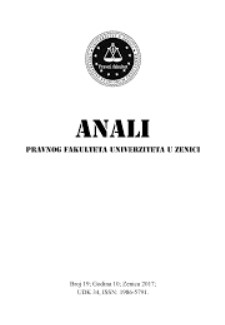ZAHTJEV ZA ZNATNO UNIŠTENJE ZNAČAJNOGA DIJELA SKUPINE: RELEVANTNOST KVANTITATIVNO-KVALITATIVNOG KRITERIJA
REQUEST FOR SUBSTANTIAL DESTRUCTION OF A SIGNIFICANT PART OF THE GROUP: RELEVANCE OF THE QUANTITATIVE-QUALITATIVE CRITERION
Author(s): Enis OmerovićSubject(s): Criminal Law, International Law, Law and Transitional Justice, Studies in violence and power, Transformation Period (1990 - 2010), Court case
Published by: Pravni fakultet - Univerzitet u Zenici
Keywords: genocide; genocidal intent; collective rights; protected groups; destruction in part; quantitative-qualitative criterion; substantial part test; significant part test; motive for genocide;
Summary/Abstract: According to the Genocide Convention definition, “genocide means any of the following acts committed with the intent to destroy, in whole or in part, a national, ethnic, racial or religious group, as such [...].” Continuing on this international legal definition of the crime of genocide, and for the purposes of the subject of our research, the question of the motives for the genocide is also raised. The following dilemma is interesting and relevant to our topic: are we attacking an individual or a group of people with genocide? A kind of introduction to the subject of our research are the rights of one group, especially the importance of its collective right to survival, which right is attacked or insulted by this international crime. The spatial aspect is also very important in terms of the possibility of committing genocide in a rather geographically limited area, while the main focus of our work is on the quantitative-qualitative criterion applied by international and domestic courts in genocide proceedings. In this regard, we will examine the relevance of this criterion in proving perpetrator’s genocidal intent, whether this criterion represents an additional tool in proving the subjective element (mens rea) of this crime or wether it represents its component, or a new item or determinant in proving the existence of genocidal intent when it comes to partial destruction of some of the four conventionally protected groups of people, all since the phrase “destruction in part” is not defined in the Genocide Convention. Furthermore, it will be examined whether this quantitative-qualitative criterion, conditionally speaking, seem controversial, without some great scientific, but also practical foundation? Significantly, another dilemma is likely here. Whether therefore appears that the prosecutor in the crime of genocide must prove that the person not only had the direct intent to commit one of the five acts of genocide, or that he had the specific intent of destroying one of the four protected groups, in whole or in part, but that he/she had the genocidal intent for the physical-biological destruction of a large number (substantial part test), or to have destroyed a significant part of a certain group (significant part test). On the other side, what is not disputable in legal science today is that mainly international case law has responded and offered its interpretation of the conventional term “in part” – what it means, what it represents, and in terms of the scope of the victims.
Journal: Anali Pravnog fakulteta Univerziteta u Zenici
- Issue Year: 13/2020
- Issue No: 26
- Page Range: 13-40
- Page Count: 28
- Language: Bosnian

